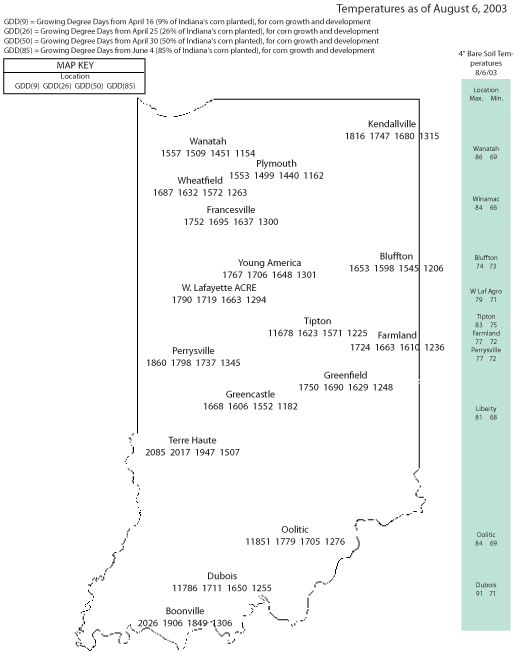Pest & Crop Newsletter
|
|||||
Soybean Aphid Update– (John Obermeyer and Larry Bledsoe)
Please refer to the last two issues of the Pest&Crop concerning this pest. Soybean aphid numbers continue to climb in research fields in northern Indiana. The most dramatic increase has been at the Pinney Purdue Agricultural Center, Porter County, where aphids per plant increased from 145 to over 600. Because of ample soil moisture and occasional rains, fields are not showing the presence of aphids or their damage. However, research trials conducted in 2001 indicate that significant yield losses can occur when plants are actively flowering and setting pods with hundreds of aphids per plant. These trials also indicate that treatment decisions need to made soon, as applications made later in August are too late. Good news! Diseased aphids are beginning to be seen, they are discolored and shrunken. This disease has been known to literally wipeout aphid populations in a few days time. Be certain to be looking for these while sampling.
Corn Growth Stage and Insect Potential– (John Obermeyer and Larry Bledsoe)
Fall armyworm moths are attracted to whorl stage corn. So far, only limited infestations have been reported in southern Indiana and Kentucky. Because of this year’s extremely late planting, there are several fields throughout the state that are still quite vulnerable to this vicious feeder. Unless one is willing to spot treat those areas infested with this pest with a high-boy, treatment should not be considered unless 60% of the normal yield is expected, 75% of the plants exhibit feeding, and the larvae are present and actively feeding. This caterpillar is difficult to control unless caught early. European corn borer moths are attracted to actively pollinating corn. Moth flights of the second generation have been low statewide in our black light traps. However, we’ve received a few reports from pest managers that indicate that “windshield splatter” has been heavy in their area at night. Scouting for egg masses and newly hatched larvae in pollinating corn is very difficult and time consuming. Control of second generation corn borer is difficult, two insecticide applications are often required. In other words, treating for this pest is not likely to be economical for yellow dent corn. High value crops, e.g., sweet and seed corn, should be monitored for egg masses and larvae. More information on each of these pests can be viewed on-line at <http://www.entm.purdue.edu/entomology/ext/fieldcropsipm/ciro.htm>.
Monitor Soybean for Rootworm Beetles Now– (John Obermeyer and Larry Bledsoe)
We are actively sweeping soybean fields to sample for western corn rootworm beetle variant populations in the state. Though we don’t have exact counts yet, it is evident that beetle numbers are down from a year ago. Stay tuned to future Pest&Crop issues as we report the catches by county. Knowledge of beetle numbers in soybean helps one to gauge the potential risk of rootworm damage to next year’s corn. Few beetles mean low risk, thus little need for rootworm protection next year. Lots of beetles means higher risk, and the insecticide “insurance” will likely pay off. Several producers and agribusiness personnel throughout the state have initiated a sampling program for their soybean fields. Because of the variability of beetle numbers from field to field, those willing to inspect soybean now may reap the benefits next spring. Sampling for rootworm beetle in soybean fields does not require sticky traps or sweep nets, but they do make decision making more accurate. Visual inspections during the morning hours, while walking through the field and carefully observing the upper canopy, should help you reach a management decision. Soybean fields should be visited weekly until early September. Refer to Pest&Crop #19, July 25, 2003, for suggested sampling with sticky traps.
Click for Table
|
|||||
Goodbye Ron Blackwell- (John Obermeyer)
Ron Blackwell, IPM Survey Specialist, is leaving us after ten years of hunting and counting insects. He will be sorely missed, as he coordinated many valuable insect IPM programs. It has been on his heart for several years to pursue a career in law enforcement. When a deputy sheriff position came open, he couldn’t resist. Should you misbehave while traveling through Clinton County, you might get to “visit” with Ron! I know that he’ll continue to think of us as his patrol car’s windshield gets splattered in the summer. He might even try to identify it.
|
|||||





